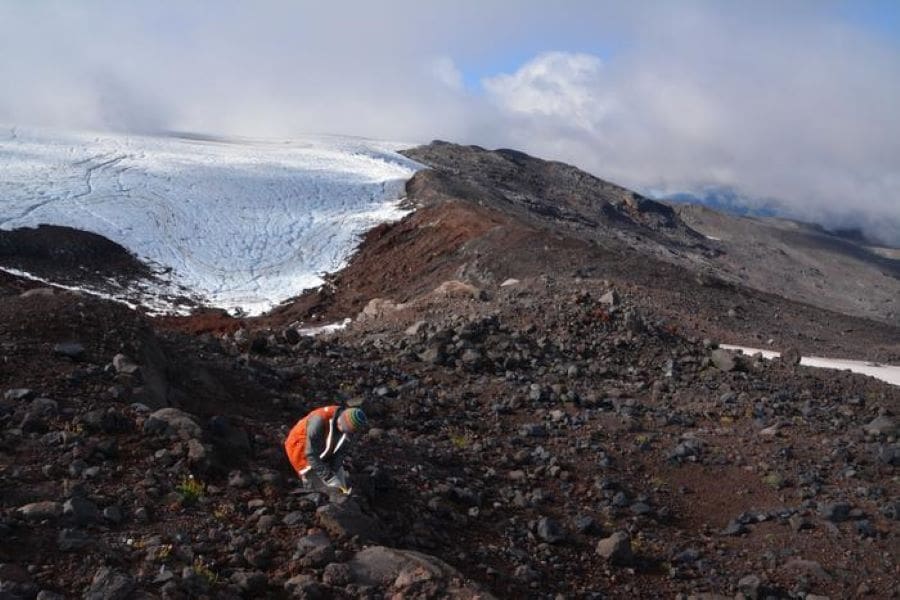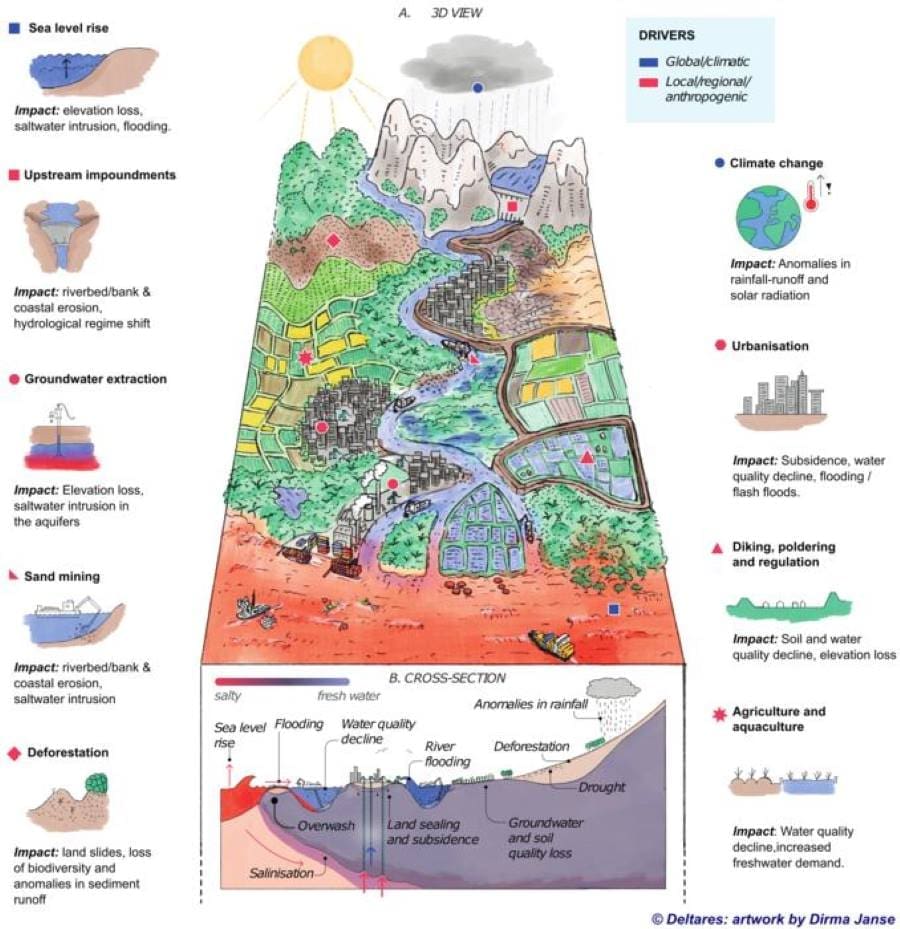Explore the latest insights from top science journals in the Muser Press daily roundup (July 8, 2025), featuring impactful research on climate change challenges.
In brief:
How plants build the microbiome they need to survive in a tough environment
The findings have significant implications for sustainable agriculture and offer a greater understanding of how complex ecosystems adapt in a changing environment.
Regents’ Professor Nancy Collins Johnson in the School of Earth and Sustainability at NAU and professor César Marín from Universidad Santo Tomás in Chile authored the paper, published in The ISME Journal, introducing the concept of functional team selection.

Put simply, plants have a microbiome in and around their roots that is composed of diverse communities of fungi, bacteria, viruses and other microorganisms. These communities help plants get nutrients and water from soil and protect plants from stress and disease. For decades, people have attempted to recreate these diverse communities, and their beneficial effects, commercially. However, these products often fail to provide the expected benefits to plants.
Functional team selection (FTS) can explain why. FTS offers a holistic perspective that envisions plants and their associated microbiomes as diverse systems of interacting organisms and viruses. Functional microbiome teams may evolve that help plants grow and thrive in seemingly difficult environments. When resources are low, if there’s enough time and a mix of helpful microbes, then plants and fungi that naturally live together can form mutually beneficial partnerships, which helps the plants grow.
“Functional teams are unlikely to evolve in benign environments with no stress and ample resources because they lack the selection pressure that is required to curate the composition of the microbiome,” Johnson said. “Evidence for FTS can be seen in studies showing that fertilization of natural vegetation often reduces mycorrhizal benefits by removing the essential selection pressure.”
Functional Team Selection is based on both ecological and evolutionary theories, including the newly proposed Law of Increasing Functional Information that explains the roles of function and selection in the evolution of all types of systems in the universe. Although FTS was developed to understand the evolution and functioning of plants and their belowground microbiomes, the FTS framework could help us understand and better manage all kinds of microbiomes that provide important functions for humans.
Journal Reference:
Nancy Collins Johnson, César Marín, ‘Functional team selection as a framework for local adaptation in plants and their belowground microbiomes’, The ISME Journal wraf137 (2025). DOI: 10.1093/ismejo/wraf137
Article Source:
Press Release/Material by Northern Arizona University
Melting glaciers could trigger more explosive eruptions globally, finds research
Melting glaciers may be silently setting the stage for more explosive and frequent volcanic eruptions in the future, according to research on six volcanoes in the Chilean Andes.
Presented today (Tuesday 8 July) at the Goldschmidt Conference in Prague, the study suggests that hundreds of dormant subglacial volcanoes worldwide – particularly in Antarctica – could become more active as climate change accelerates glacier retreat.
The link between retreating glaciers and increased volcanic activity has been known in Iceland since the 1970s, but this is one of the first studies to explore the phenomenon in continental volcanic systems. The findings could help scientists better understand and predict volcanic activity in glacier-covered regions.
Researchers from the University of Wisconsin-Madison, USA, used argon dating and crystal analysis across six volcanoes in southern Chile, including the now dormant Mocho-Choshuenco volcano, to investigate how the Patagonian Ice Sheet’s advance and retreat influenced past volcanic behaviour. The work is in collaboration with researchers from Lehigh University, University of California Los Angeles, and Dickinson College.

By precisely dating previous eruptions and analysing crystals in erupted rocks, the team tracked how the weight and pressure of glacial ice alter the characteristics of magma underground.
They found that during the peak of the last ice age (around 26,000–18,000 years ago), thick ice cover suppressed the volume of eruptions and allowed a large reservoir of silica-rich magma to accumulate 10-15 km below the surface.
As the ice sheet melted rapidly at the end of the last ice age, the sudden loss of weight caused the crust to relax and gasses in the magma to expand. This buildup of pressure triggered explosive volcanic eruptions from the deep reservoir, causing the volcano to form.
Pablo Moreno-Yaeger from the University of Wisconsin-Madison, USA, is presenting the research at the Goldschmidt Conference. He said: “Glaciers tend to suppress the volume of eruptions from the volcanoes beneath them. But as glaciers retreat due to climate change, our findings suggest these volcanoes go on to erupt more frequently and more explosively. The key requirement for increased explosivity is initially having a very thick glacial coverage over a magma chamber, and the trigger point is when these glaciers start to retreat, releasing pressure – which is currently happening in places like Antarctica.
“Our study suggests this phenomenon isn’t limited to Iceland, where increased volcanicity has been observed, but could also occur in Antarctica. Other continental regions, like parts of North America, New Zealand and Russia, also now warrant closer scientific attention.”
While the volcanic response to glacial melting is almost instant in geological terms, the process of changes in the magma system is gradual and occurs over centuries, giving some time for monitoring and early warning.
The researchers also note that increased volcanic activity could have global climate impacts. In the short term, eruptions release aerosol (tiny particles in gases) that can temporarily cool the planet. This was seen after the 1991 eruption of Mount Pinatubo in the Philippines, which reduced global temperatures by approximately 0.5 degrees C. But with multiple eruptions, the effects reverse.
“Over time the cumulative effect of multiple eruptions can contribute to long-term global warming because of a buildup of greenhouse gases,” said Moreno-Yaeger. “This creates a positive feedback loop, where melting glaciers trigger eruptions, and the eruptions in turn could contribute to further warming and melting.”
***
The research was funded by the National Science Foundation as part of a grant led by Professor Brad Singer at UW-Madison, and is due to be published in a peer-reviewed journal later this year.
The Goldschmidt Conference is the world’s foremost geochemistry conference. It is a joint congress of the European Association of Geochemistry and the Geochemical Society (US), and over 4000 delegates attend. It takes place in Prague, Czech Republic, from 6-11 July 2025.
Article Source:
Press Release/Material by European Association of Geochemistry
Paving the way towards green hydrogen at scale
A recent review in Nature Reviews Clean Technology presents, for the first time, a pathway for scaling up decoupled water electrolysis (DWE) technologies to produce industrial-scale green hydrogen.
Hydrogen, a key chemical feedstock, is usually produced from fossil fuels, generating high CO2 emissions. Water electrolysis powered by renewable energy emits oxygen rather than CO2 and offers a clean alternative. Green hydrogen production on an industrial scale is one of the holy grails of the energy transition, as it would unlock the potential of replacing the world’s dependency on fossil fuels.
Conventional electrolysis uses two electrodes separated by a membrane to split water into hydrogen and oxygen. This approach is expensive, suffers from internal hydrogen leakage, and is incompatible with intermittent solar and wind power. DWE overcomes these issues by separating the hydrogen and oxygen production in time or space, eliminating the need for membranes. Rather, it uses redox materials that can absorb and release ions from which oxygen or hydrogen are produced.
The article reviews different DWE methods and, for the first time, presents feasible scale-up pathways. The authors include leading experts from all over the world: Prof. Avner Rothschild of the Technion Faculty of Materials Science and Engineering, Prof. Mark D. Symes of the University of Glasgow, Prof. Jens Oluf Jensen of the Technical University of Denmark, Dr. Tom Smolinka of the Fraunhofer Institute for Solar Energy Systems ISE, Rotem Arad and Gilad Yogev from the company H2Pro, Technion postdoctoral fellow Dr. Guilin Ruan, and University of Glasgow doctoral student Fiona Todman.
Prof. Mark Symes and his collaborators at the University of Glasgow pioneered the original embodiment of decoupled electrolysis in 2013, using solution-phase redox mediators. He has continued his work on decoupled electrolysis using a variety of liquid-based systems and is actively trying to commercialize this technology through the company Clyde Hydrogen Systems.
In 2015, Prof. Avner Rothschild pioneered a new technology together with Technion colleagues Prof. Gideon Grader, Dr. Hen Dotan, and Dr. Avigail Landman, using nickel-based redox electrodes. Their breakthrough led to the founding of H2Pro in 2019. The company stands at the forefront of commercializing DWE. H2Pro’s patented technology entails a streamlined, membrane-less system, cost-effective materials, and low capital costs. H2Pro is currently scaling up this technology and preparing to install the world’s first DWE system. The system is ideally suited to cope with intermittent renewable energy sources such as solar and wind.
Prof. Jens Oluf Jensen and Dr. Tom Smolinka are world-renowned experts on state-of-the-art electrolyzer technologies. Their work in proton exchange membranes (PEM), anion exchange membranes (AEM), electrode materials, and their application in cell stacks for large capacity PEM and AEM electrolyzers provided valuable insight into the challenges of scale-up and operation of commercial electrolyzers, and a sound base for comparison of disruptive decoupled and membrane-less electrolyzer concepts. Rotem Arad and Gilad Yogev provide insights into transforming these concepts into technologies for green hydrogen production at scale.
This review is the first to detail feasible scale-up strategies for DWE. While lab-scale DWE experiments produce less than a gram of hydrogen per day, industrial systems must generate about a ton daily – a million times more! Indeed, meeting current hydrogen demand would require around a million full-scale electrolyzers. Conventional industrial electrolyzers, on the other hand, require a stable grid supply and can only be used to a limited extent with highly dynamic power fluctuations such as those caused by solar and wind energy.
DWE’s unique advantage lies in its energy storage capability via redox materials, functioning like an electrolyzer with a built-in battery. This allows it to buffer energy fluctuations from renewable sources, making it highly compatible with solar and wind systems, thereby offering a critical pathway to low-cost, green renewable hydrogen production.
The potential impact of scaling up green hydrogen production is huge. The hydrogen market is currently worth about $250 billion annually. Once it becomes available on an industrial scale, the market for green hydrogen is expected to reach $550 billion within ten years.
“Green hydrogen is expected to account for 10% of the future energy market. Once it becomes possible to produce green hydrogen at large-scale and sell it at reasonable prices, hydrogen will replace a large part of the energy used in industry, heavy transportation, and other sectors,” Prof. Rothschild predicted. “Traditional electrolyzers should evolve to fit this market and, as noted by Darwin, it is not the strongest species that survives through evolution but, rather, the one that is best able to adapt and adjust to the changing environment in which it finds itself. I believe DWE would be it.”
“Decoupled electrolysis is only about 12 years old. More conventional technologies, such as alkaline and proton-exchange membrane cells, have had decades (if not centuries) for development. This gives some context to the rate of scaling of some of the new decoupled systems starting to emerge,” elaborated Prof. Symes. “On the current trajectory, I expect that the next decade will see decoupled electrolysis systems becoming serious competitors to more conventional electrolyzers, especially for the conversion of renewable energy to green hydrogen.”
The new ideas presented in the review article are compelling and shed light on the long-term prospects of scaling up DWE technologies for the benefit of all humanity.
Journal Reference:
Ruan, G., Todman, F., Yogev, G. et al., ‘Technologies and prospects for decoupled and membraneless water electrolysis’, Nature Reviews Clean Technology 1, 380–395 (2025). DOI: 10.1038/s44359-025-00061-1
Article Source:
Press Release/Material by Technion-Israel Institute of Technology
Scientists warn of urgent need to tackle changes impacting river deltas
Deltas are low-lying areas that form as rivers and empty their water and sediment into another body of water, such as an ocean, lake, or another river.
Some of the largest in the world, such as the Rhine, Mekong, Ganges-Brahmaputra-Meghna, and Nile, are threatened by climate change, facing rising sea levels and increasing frequency of extreme events.
With approximately 500 million people today living within or adjacent to delta systems, this is a major issue.
To address this, a team of international scientists has developed a new framework that identifies the 10 main drivers of change in deltas globally. These are: climate change, sea level rise, deforestation, intense agriculture, urbanisation, impoundments, land subsidence, ground water extraction, flood defences, and resources mining.
Most local, human-induced causes show measurable impacts within years and the framework provides a clear basis for prioritising timely, locally grounded action with a deeper understanding of the systems that shape these complex and dynamic environments.
Publishing their findings in Nature Climate Change, the team includes scientists from the Universities of East Anglia (UEA), Southampton and Oxford in the UK, and Deltares, TU Delft, Wageningen University and Utrecht University in The Netherlands.

“Deltas are the most complex coastal systems in the world and recognising these multiple drivers and how they operate in each delta is fundamental to finding solutions,” said co-author Prof Robert Nicholls, from the Tyndall Centre for Climate Change Research at UEA and the University of Southampton.
Effective adaptation requires more than isolated measures, that often overlook an important step in deeper assessments of the system as a whole.
The diagnostic framework links these drivers of change with their direct and indirect impacts across scales in time and space (divided in centuries, decades or temporal scales). It is intended to support policymakers, technocrats, engineers, and stakeholders in developing locally grounded adaptation strategies that are both realistic and resilient.
It aims to help identify and understand the interconnectivities within the biophysical system, from source to sink, and how these link with local/regional/transboundary socio-economic structures.
While climate change threatens the world’s deltas, anthropogenic drivers – largely reflected in sediment starvation and resource extraction, profound land-use change and hydrological regime shifts – can outpace climate change in the short to medium term.
Nearly all local anthropogenic drivers result in measurable impacts within years or decades, emphasising the significance and relevance of local and regional causes for effective and timely climate adaptation and policy development.
“If we want to give deltas a real chance at long-term climate resilience, we need collective comprehension of the human footprint and the underlying drivers of change,” said Dr Sepehr Eslami, lead author and coastal expert at Deltares.
“By promoting system-level thinking, this framework encourages more critical and collaborative approaches to adaptation. It helps identify the solutions with the highest chance of being implemented successfully, especially when embedded in a longer-term vision.”
The diagnostic framework can also foster constructive dialogue among stakeholders and ensure that adaptation efforts are both science-based and socially relevant.
“Decision making in delta systems is extremely difficult due to all the complex interactions between different processes,” added Dr Amelie Paszkowski from the University of Oxford.
“But this framework helps to disentangle these dynamics and diagnose the challenges in a delta, which is a fundamental first step in defining adaptation solutions that tackle the root causes of the impacts felt.”
The research was inspired by the work of the Rise and Fall Project, a collaboration between Deltares and the Utrecht University, and also involved researchers from the University of Cologne and University of Padova.
Over a period of nearly three years, the team combined decades of knowledge on vulnerabilities in deltas and adaptation efforts to develop a framework that can facilitate diagnosing the key processes and interactions shaping a delta system. The goal: to offer a holistic foundation for planning effective, context-sensitive adaptation strategies.
Journal Reference:
Eslami, S., Oude Essink, G., Paszkowski, A. et al., ‘A systems perspective for climate adaptation in deltas’, Nature Climate Change 15, 687–691 (2025). DOI: 10.1038/s41558-025-02368-0
Article Source:
Press Release/Material by University of East Anglia (UEA)
Featured image credit: Gerd Altmann | Pixabay



![Image: Jowar [sorghum] bud at initial stage (s. climate, science, research)](https://www.muser.press/wp-content/uploads/2024/09/Jowar_Sorghum-muser-res-1-1024x768.jpg)
